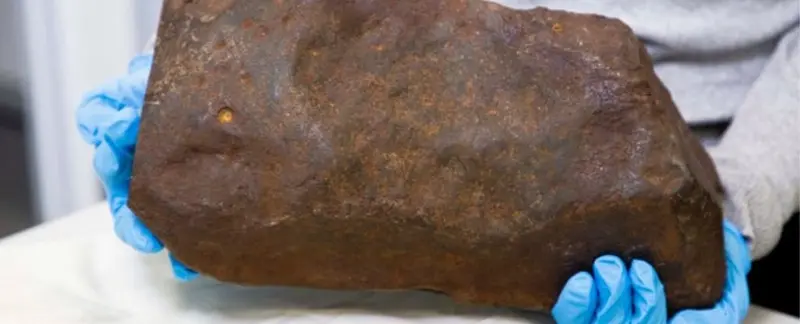For years, a man kept a mysterious boulder discovered in the Maryborough regional park using a metal detector. David Gould hoped that inside the found object… stone a gold nugget is hidden.
What did the discovery turn out to be?
But let’s go back to 2015. When Gohl brought the stone home, he tried every possible way to break or cut it. Such a persistent desire can likely be explained by the fact that the Maryborough Park is located in the Goldfields region, known for the gold rush of the 19th century.
Goul tried to reach the “insides” of the stone using a special saw, an angle grinder, and a drill. He even poured acid on his find. A sledgehammer couldn’t make a single crack either. And that’s because it wasn’t an earthly stone. Plus, there was no gold nugget inside it.
Years passed during which the stone’s super-resilience kept the intrigued Goul restless. Eventually, he took the boulder to the Melbourne Museum for identification.
There, the gold hunter learned that what he had been trying to uncover in vain was a rare meteorite.
How did the experts comment on this surprise?
“The stone was sculptural, with dimples. Such features usually form when they pass through the atmosphere; they melt on the outside, and the atmosphere shapes them,” shared Dermot Henry, the museum’s geologist, about his first impression of the cosmic rarity.
The expert also mentioned that in his 37 years of research work at the museum, he has seen many stones that people believed to be meteorites. During this time, out of thousands of samples, only two turned out to be genuine meteorites. The second one was the one brought by David Gould, the publication reported. Science Alert .
What have scientists learned about the meteorite?
Researchers published an article on the results of their analysis of the stone. It states that meteorite named Meriboro, 4.6 billion years.
Despite its modest size, it weighs 17 kilograms. This is also a certain confirmation of its extraterrestrial origin. “If you saw such a stone on Earth and picked it up, it wouldn’t be this heavy,” noted Bill Birch, a museum geologist and researcher.
By separating a small piece from the meteorite with a diamond saw, scientists discovered that it has a high content of iron This makes it an ordinary H5 chondrite.
After the “dissection” of Meriboro, scientists also observed tiny crystallized inclusions of metallic minerals known as chondrules.

“Meteorites are the cheapest form of space exploration. They take us back in time, providing clues about the age, formation, and chemistry of our Solar System, including Earth,” noted Dermot Henry.
“Some of them allow us to glimpse into the depths of our planet. Some meteorites contain ‘stardust’ that is even older than our Solar System,” the scientist added. According to him, rare meteorites may contain organic molecules, such as amino acids – “the building blocks of life.”
Although researchers do not yet know where Meriboro came from or how long it may have been on Earth, they have some guesses.
Our Solar System was once a swirling mass of dust and chondritic rocks. Eventually, gravity gathered most of this material into planets, while the remnants ended up in a vast asteroid belt.
“This particular meteorite most likely came from the asteroid belt between Mars and Jupiter, and it was ejected from there by several colliding asteroids before it crashed into Earth,” Henry said.
Radiocarbon analysis showed that the meteorite had been on Earth for 100 to 1000 years. Between 1889 and 1951, several meteorites were recorded, one of which could have been the Meriboro.
Researchers claim that this meteorite is much rarer than gold, making the discovery highly valuable for science.
This is only the 17th meteorite discovered in the Australian state of Victoria, while gold nuggets have been found here by the thousands, Mr. Henry noted. He added, “Considering the chain of events, it can be said that this is literally an astronomical discovery.”
The results of the study were published in the journal Proceedings of the Royal Society of Victoria.
